Welcome to
Leytonstone Bellringers' Webpage!
St John the Baptist Church
Leytonstone,
London E11
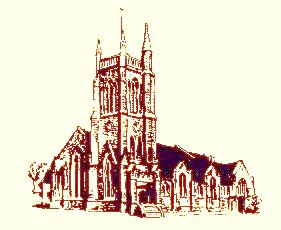
Welcome toLeytonstone Bellringers' Webpage!St John the Baptist Church
Leytonstone,
|
|
The ringers of St John's Leytonstone:-
Ian Boyce, Don Clark, Rosemary Finzel, Joy Le
Gallez,
Helen Johnson, Denis Mitchell,
Bet Mitchell, Michael Wareing
would like to welcome you to our Web Page and to invite you to visit our Tower. Please come on any Practice Night or when we are ringing for Service .
We hope that these pages will be of interest to non-ringers as well as to ringers.
St John the Baptist's is the Parish Church of Leytonstone, in the Diocese of Chelmsford. Its tower houses a fine ring of 8 bells (tenor: 12 cwt in G). The tower and ringers are affiliated to the Essex Association of Change Ringers. Visitors are always welcome - whether ringers or non-ringers. We are justly famous for our refreshing cups of tea - served half way through practice nights - an almost unique experience in the world of bellringing!
Contents
|
from an old print of St John's |
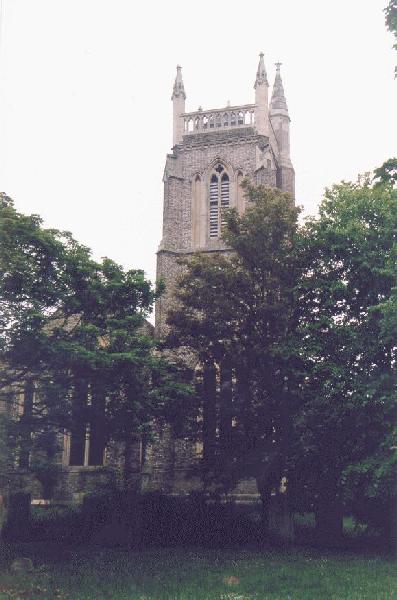 |
Leytonstone was originally part of the
Parish of St. Mary, Leyton. There was a small chapel for
the inhabitants of Leytonstone from the middle of the
18th century. The present church was built close to the
site of the old chapel. Building commenced in 1832. It
was dedicated on 31st October 1833. The Church was
designed by Edward Blore in the Early English style, in
yellow brick and stone dressings. It has a fine tower of
four stories in which the bells are hung. Edward Blore's
designs are in the Victoria & Albert Museum. Leytonstone in those days consisted of open fields, streams, and a few large houses. With the expansion of London and the coming of the railway, it soon became a suburb of East London. It retains some rural charm however, through the survival of a southern branch of Epping Forest running right down into this part of London. A large part of the Parish is bordered by ancient woodland and common land on which commoners still graze their cattle. NOTE - Visitors approaching by car in summer need to keep a sharp lookout for cows who will happily cross the busy main road without proper kerb-drill! They also sometimes graze in the churchyard!! |
| Today the churchyard is a green space in
the built-up centre of Leytonstone alongside a busy route
into Central London. The church today is used by about
150 regular members. It reflects the many different
cultures of the area and tries to help with some of the
needs of the community - from a Mothers and Toddlers
Group to a Winter Night Shelter for the Homeless and from
a Wednesday "Drop in Centre" to helping, with
other Christian Churches, to run a mobile Christian
Kitchen to feed those in need. We also have a variety of Services - 1662 Holy Communion - Family Services - Rite A Morning & Evening Communion Services - Evensong and Mattins. |
Sunday Service ringing is from 10:00 to 10:30 a.m and from 6:00 to 6:30pm every Sunday.
Practice Night is Monday from 7:30 to 9:15 p.m. The first half hour in particular is normally devoted to bell handling practice for beginners.
It is always advisable for visitors to check in advance to confirm because occasionally ringing may be cancelled due to special circumstances. We do not ring on Bank Holiday Mondays nor during Holy Week.
| Bellringing Master | : | Michael Wareing | Tel: 0181-989-4260 | ||
| E-mail Contact | : | Denis Mitchell | Tel: 0181-539-0135 | e-mail: DHMNo2@aol.com |
St Johns have always maintained a band of bellringers from the time that the old six were hung in 1833. The peal boards, the photos, and the old diaries and minute books bear witness to the long and continuous tradition of good ringing. As far as we can tell the tower has never been "silent" except during the years of the Second World War - when all bells in Britain were silenced, only to be rung in the event of an invasion.
Up until the last thirty or forty years the typical Leytonstone ringer would probably have fitted the traditional image of the old school of bellringer. Ringers were almost exclusively male. They normally wore a suit, but removed their jackets to ring. They hung up their jackets, and hats or cloth caps, rolled up their shirt sleeves and looked very smart with waist coats and watch-chains - and sometimes no collars. They normally rang the same bell every week.
Nowadays things have changed considerably in our tower - as elsewhere. People ring at any age from 10 upwards. There are at least as many women as men ringers. We wear whatever clothes we feel comfortable in. We enjoy ringing different bells - to get used to their different handling characteristics.
Increased mobility has also affected all towers. Young people learn and then go off to University and/or move away from the area so there is a much more rapid turnover of ringers than in the past. However new recruits are found who are keen to learn. The standard of ringing in most towers fluctuates quite rapidly as experienced ringers move away and the newer ringers take time to "learn the ropes".
Before and after the War, in the 1930s and 1950s & into the 1960s, the St John's ringers enjoyed a reputation for a very high standard of ringing. - and a number of our ringers were well known in ringing circles. In this period a number of firsts were achieved, some of which are recorded on peal boards. The Ringing Master at St John's, Mr Charlie Willmington, was honoured by being made a Life Vice-President of the Essex Association of Change Ringers.
The present standard of ringing at St John's varies from "a bit of a struggle" to "fairly average for the area". We are always trying to improve our ringing and we have an "open house" policy to any new learners that come our way. Many of St John's ringers are long term friends and we would like to extend our circle of friendship. On special occasions we can sometimes muster enough experienced ringers to ring all 8 bells. But often we must be content with ringing 6 or less. The more experienced ringers are capable of very basic method ringing and the less experienced are learning to ring plain hunt. On Sundays we normally ring rounds and called changes - but will always be prepared to ring a simple method if there are enough ringers to make it possible.
Ringers are a hospitable bunch and our Tower is no exception. Visitors are always welcome. We naturally welcome non-ringers who want to see what it is like and perhaps have a go under the careful supervision of an instructor - in order to see whether they would like to continue and learn to ring. Ringers of any standard who have moved into the area will be very welcome to come and ring with us. We are very happy to welcome lapsed ringers who learned somewhere, sometime in the past and would like to take it up again. You are very welcome to come along and pick up where you left off. Those who have acquired basic handling skills in their own tower and want to get experience of ringing in other towers will not need to worry that they will be "outclassed" by very advanced ringing in which they will feel out of place. At the same time we are happy to welcome more accomplished ringers. You must not expect to find a practice night offering some very technically difficult ringing at the moment. Nevertheless you will be able to provide a good service to our struggling learners by ringing steadily and reliably - and with your help we may be able to attempt something ambitious for us - such as a doubles method.
The tower houses a ring of 8 bells
To hear St John's bells in action click HERE - this is a few seconds recording from a recent peal of Bristol Surprise Major by the Guild of St James.
| No: | Cwts-qrs-lbs | Kilograms | Date | Inscription/Name |
|---|---|---|---|---|
| Treble | 5-0-18 | 262 | 1936 | Gillett & Johnston Croydon 1936 - William Pye 1870-1935 - The two trebles of this peal were given by the Ringing Exercise in memory of a great ringer |
| 2 | 5-2-11 | 284 | 1936 | Gillett & Johnston Croydon 1936 - All these were honoured in their generation. All were the glory of their times |
| 3 | 5-3-5 | 294 | 1833 | Agnes |
| 4 | 6-0-4 | 307 | 1833 | Phoebe |
| 5 | 6-3-18 | 351 | 1833 | Sarah |
| 6 | 7-1-13 | 374 | 1833 | Eliza |
| 7 | 9-3-0 | 495 | 1833 | Dorothy Anne |
| Tenor | 12-3-0 | 648 | 1833 | This bell with five more to form a
peal was presented to the new chapel of Leytonstone by
William Davis Esquire A.D. 1833 |
| The weights above are quoted both in the old Imperial
system, showing hundredweights (cwts) - quarters (qtrs) -
pounds (lbs), and in the Metric system - kilograms. The original 6 bells are named after the womenfolk of the Davis (aka Davies) and Cotton families - who were benefactors of Leytonstone Church. They were cast by T. Mears at Whitechapel in 1833. The two trebles, as the inscriptions say, were cast by Gillett & Johnston of Croydon in 1936. Click HERE to see a reproduction of Gillett & Johnston's original chart (I've had to touch up the scanned image to restore the faded red ink and to remove some stains and blemishes which made it unreadable) |
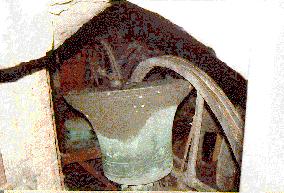 view of no.3 "Agnes" from the stairs |
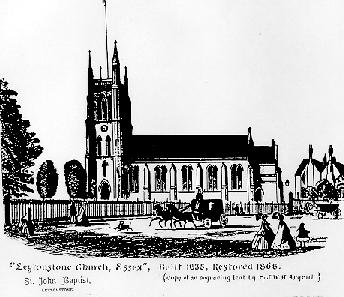 |
View of St Johns in 1868 St John's is located by the traffic lights on the corner of Leytonstone High Road (which is on the A12 main route into London from Chelmsford) and Church Lane, just a short walk down Church Lane from Leytonstone Underground Station (Central Line) and the Bus Depot. It is a short drive westwards from the current southern end of the M11 motorway and from the North Circular Road. Visitors to Leytonstone by car should be aware that a new extension to the M11 is being built and there are likely to be roadworks and delays for the foreseeable future. Allow extra time for your journey. |
| The main entrance to the church is via the South Door
at the base of the Tower facing the church car park on
the corner by the traffic lights. For security reasons
the door is normally locked on practice nights soon after
the start. Please rattle the door very loudly to attract
our attention between bouts of ringing. Someone will come
down to let you in. Parking is available at the front of the church. There is plenty of space on practice nights but beware of being boxed in when ringing for Sunday service if you should need to leave promptly after ringing. Parking is also usually possible in the car park at the back of the Pioneer Supermarket, adjacent to the churchyard. The church gate is on the corner by the traffic lights. Why not come on a virtual tour of the tower? View of St John's in 1998 |
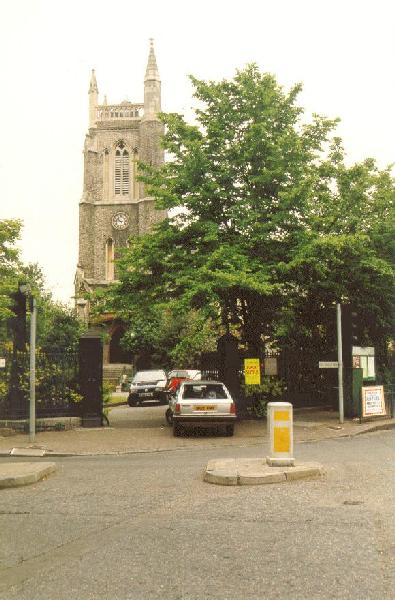 |
This page created 29th May 1998
Webmaster: anthony.brickell@bl.uk
Possibly the first Tower in Essex to
have a Web Page!
Last updated 22nd Jan 1999.